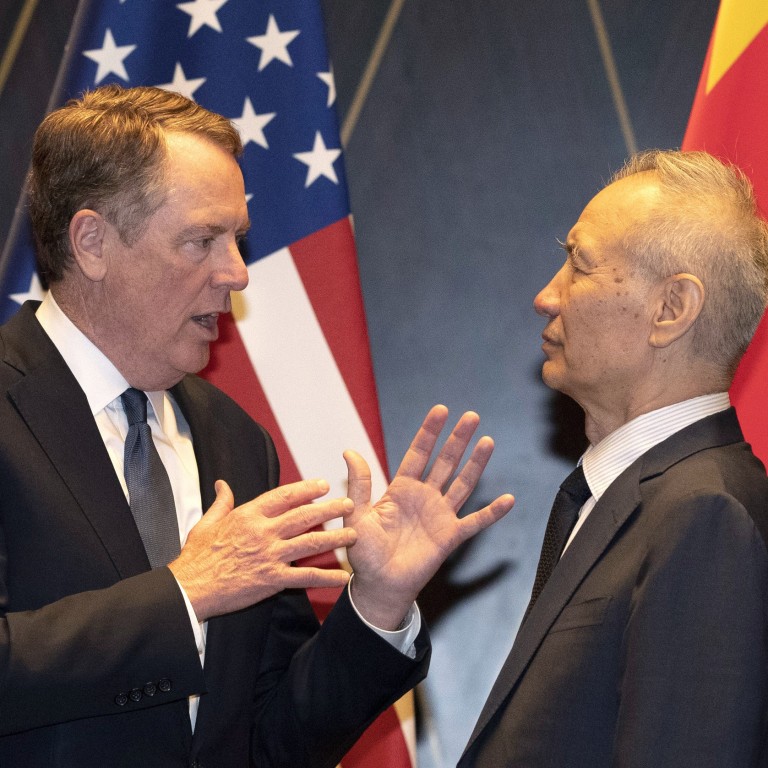
China’s yuan rallies after report currency pact may be included in possible interim US trade war deal
- Delegation led by China’s Vice-Premier Liu He will meet their US counterparts in Washington on Thursday and Friday
- Pact may to be similar to the proposed United States-Mexico-Canada Agreement (USMCA), including refraining from currency devaluations
China’s yuan exchange rate rose sharply on Thursday as the possibility that a currency pact could be included in a small-scale trade deal between China and the United States helped fuel optimism ahead of talks resuming in Washington.
The contents of the currency section in any US-China deal would likely bear similarities to the proposed United States-Mexico-Canada Agreement (USMCA), which the US Congress has yet to vote on, analysts said. At the time, US officials said that the USMCA currency section was a template which would be used in future US trade negotiations.
The USMCA currency section, as currently written, requires the signatories to refrain from currency devaluations to seek trade advantage and also increases transparency of information sharing about government foreign exchange operations such as currency market interventions.
OCBC Bank economist Tommy Xie Dongming said that it should not be a problem for China to promise to refrain from competitive devaluations in the yuan’s exchange rate as it already agreed to a G20 statement in 2013 opposing competitive currency devaluations.
The yuan was changing hands at 7.1252 against the US dollar late on Thursday afternoon, up 0.8 per cent from early September when it hit its weakest level in 11 years.
This follows the People’s Bank of China setting the daily yuan reference rate slightly stronger than market expectations in the past month or so, signalling its intention to prevent a sharp depreciation in the yuan against the US dollar.
Even though China seldom intervenes in its currency directly nowadays, we know that China doesn’t like the feeling of being forced to disclose certain intervention information. So one focus of this currency pact would be related to China’s transparency issues
The key issue in any currency pact would be China’s willingness to agree to more transparency in its currency market operations, Xie said, such as how the PBOC would notify the US of any intervention in the foreign exchange market and the type of information that would be disclosed in terms of official trading in the yuan spot and forward markets.
“Even though China seldom intervenes in its currency directly nowadays, we know that China doesn’t like the feeling of being forced to disclose certain intervention information,” Xie said. “So one focus of this currency pact would be related to China’s transparency issues.”
Vice-Premier Liu He is leading China’s delegation to resume trade talks with US Trade Representative Robert Lighthizer and US Treasury Secretary Steven Mnuchin on Thursday and Friday in Washington. It is the first meeting between the countries’ top negotiators on US soil since the talks collapsed in May.
China is reported to be looking to narrow the scope of discussions for a possible partial trade deal that would include large Chinese agricultural and energy purchases in exchange for postponing planned tariff increases later this year but without addressing some key US demands on intellectual property protection and industrial subsidy reform.
The US plans to raise duties from 25 per cent to 30 per cent on around US$250 billion of Chinese imports on Tuesday. In addition, new duties of 15 per cent on around US$160 billion of Chinese consumer goods – including smart phones and consumer electronics – are set to take effect on December 15.
“It seems China is no longer insisting on a rollback of tariffs before negotiations go ahead. It seems they are more open to negotiate first, and then have a partial deal to put a stop to further increases of tariffs, and then to move on to further negotiations to remove tariffs,” Xie said.
Xie added that any currency pact in an interim trade agreement could also be a catalyst for the US to remove its designation of China as a currency manipulator.
It was a definition that runs opposite to what market players widely accept for currency manipulation – that is, that a currency weakens due to official intervention rather than by market supply and demand conditions.
But the US appears to be shifting its strategy towards a broad-spectrum confrontation over economic and technological power, as well as political values. This week, the US blacklisted 20 Chinese public security bureaus and eight hi-tech firms while imposing visa restrictions on Chinese officials in response to China’s treatment of Muslim minorities in Xinjiang province.
“Even with a limited trade agreement, which might now be in the works, we don’t expect the trade conflict to go away,” said Nick Marro, global trade lead, at The Economist Intelligence Unit. “The tariff drama has become secondary to a much larger, more painful narrative of US-China bilateral friction. Unfortunately, those larger issues are going to stay for the long-term.”

